Common preamble to three posts on changes to place over the last 50 years
I recently posted an unpublished and not previously circulated essay at Academia.org on the ways that places and place experiences have altered since about 1970. It draws on some of my posts on this website, and also on my publications about place (mostly book chapters that might not be easily available) since about 1990. My main reason for writing the essay is that experiences of being rooted in place, belonging, attachment and so on, and indeed the forces of placelessness that might be eroding these, are not timeless and unchanging. What made sense in 1970, when I was writing my book Place and Placelessness, needs to be updated both because there are now practices for protecting, making and promoting places that did not exist then, and because the ways places are experienced have shifted dramatically in a world of cheap air travel and omnipresent electronic devices.
I assume that those looking at this website and those reading Academia are mostly from two different audiences, so this and two additional posts offer a sort of point form summary of my Academia essay, which is about 60 pages long. This post (#1) considers recent changes to the ways places are made. The next post (#2) deals mostly with changes since 1970 to the ways places are experienced. The third post (#3) offers some theoretical speculations about changing relationships between place and placelessness and what they portend for the future of places.
Although they are really only summaries of ideas, I hope that together the three posts offer enough suggestions about recent changes for you to be able to explore them further, perhaps question some conventional assumptions about roots and sense of place, or, conversely, to refine arguments that place provides continuity in the face of change.
Changes to places since 1970 that reinforce distinctiveness
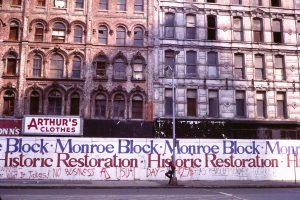
Early Heritage Protection at work. Detroit in the 1980s
1.Heritage Protection. Heritage in the sense of protecting distinctive buildings and place from demolition was effectively an invention of the 1970s, especially a UNESCO convention in 1972 on the protection of cultural and natural heritage that led to the creation of World Heritage Sites and encouraged nations to develop heritage protection policies. From the mid-70s heritage protection was rapidly and widely adopted through legislation and planning practices and it has become a powerful force for protecting the identity of places that it is an essential consideration in most forms of urban development.
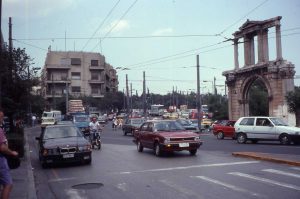
Hadrian’s Gate in Athens, probably built about 130 AD, surrounded by traffic in 1990
Heritage preservation is not unproblematic. An honest assessment is that the results often seem to be jumbled amalgam of buildings and bits from different eras that happen not to have been destroyed. Moreover, there are questions about exactly whose heritage is worth preserving, and heritage sites can be awkwardly out of context. Nevertheless, it is clear that there has been a dramatic change in the treatment of places between the 1950s and 60s, when almost anything or anywhere old was considered obsolete and in need of renewal, and the present-day, when almost all development has to protect old buildings and archaeological sites as a way to maintain visible links to the past of places.
2.Treatment of Natural Environments. The development of policies for environmental protection happened at much the same time as the emergence of heritage protection. In the 50s and 60s natural environments were usually engineered into submission, bulldozed, dammed, destroyed. But since about 1970 environmental conservation and ecological understanding have become accepted practices of most planning and development. Of course, there are still instances of wanton environmental destruction, but there is now widespread recognition of the importance of sustainability (a concept developed in the 1980s) and the need to work with rather than against natural processes and environmental conditions. The result has been that the environmental distinctiveness of places, which 50 years ago would have been of little consequence, is now usually regarded as an amenity to be protected or even reconstituted in cases where it was more or less obliterated.
Here is a specific case:
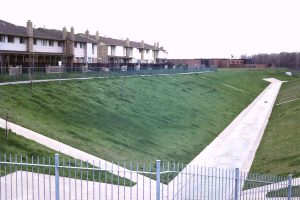

On the left, a creek in suburban Toronto abut 1970, engineered into a concrete channel to speed run-off. On the right, a section of the same creek in 2005 that had recently been re-engineered into something approximating its original ecological characteristics in order to slow run-off.

Mississauga Civic Centre, built in the 1980s, is a post-modern design intended to echo the elements of farms that once dominated this region of Ontario – farmhouse in front, barn behind, wind pump (clock tower) and just visible on the right a silo that serves as the council chamber.
3. Post-modern design. Contemporary with the rise of heritage protection was a movement in architecture and urban planning away from simplistic modernist designs. In architecture these “post-modern” approaches incorporated decorative elements, and quoted older building forms styles. At the larger scale of planning post-modernism was revealed in “new urbanism” and “neo-traditionalism” which aimed to echo regional traditions of domestic building and street layouts with features such as rear laneways and front porches. These post-modern design approaches have reintroduced elements of distinctiveness, especially in master planned developments, into suburban landscapes.
Post-modern design is significant not just a design style, but because it is a visible expression of what in philosophy appears to be a fundamental epistemological shift associated with the decline of the rationalistic approaches of modernist philosophy that promoted uniform ways of thinking and doing. Post-modernism acknowledges diversity, a shift that is apparent socially in the emergence over the last 50 years of civil rights, gay rights and the women’s movement. I discuss the implications of this shift in the third post in this series about theoretical shifts in the relationships between place and placelessness.
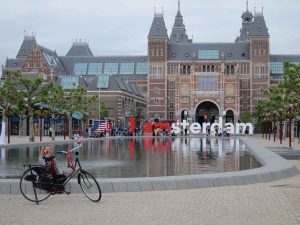
Amsterdam scarcely needed branding but did it anyway. The epicentre of the I Amsterdam brand at the Rijksmuseum.
4. Place branding. Modern economic globalization is powerfully positivist in its commitment to numbers and rationalistic abstractions. It was initially assumed that rational economic decisions about where to locate businesses had nothing to do with the qualities of places. By the late 1980s it had become clear that this was a flawed assumption and that investment was heading to places that had qualities other than an economically efficient location. The response to this was the business-oriented practice of place branding, a practice that encourages places to promote their distinctive qualities, whether environment, culture, history, in order to attract investment. In the last thirty years place branding has become an important aspect of marketing not only for cities and regions but also for universities, and there are academic programmes and journals devoted to it.
Place branding is held to be most effective when it is based on manifest qualities of a place, and the skill is in identifying and amplifying those. This requires that a place lives up to its brand image, and that can involve such things as investing in destination architecture, and policies that reinforce, for instance, heritage character and other aspects of distinctiveness.
5. Place making. As place branding became increasingly popular from the 1990s on, so, quite independently, did the idea and practice of placemaking. There were a few isolated discussions about placemaking before then, including my own in Place and Placelessness, but it was the publication in 1995 of Linda Schneekloth and Robert Shibley Placemaking: the art and practice of building communities (Wiley), that seems to have triggered widespread interest. There are now thousands of publications devoted to it, numerous consultancies specializing in it, and official plans that attempt to implement it.
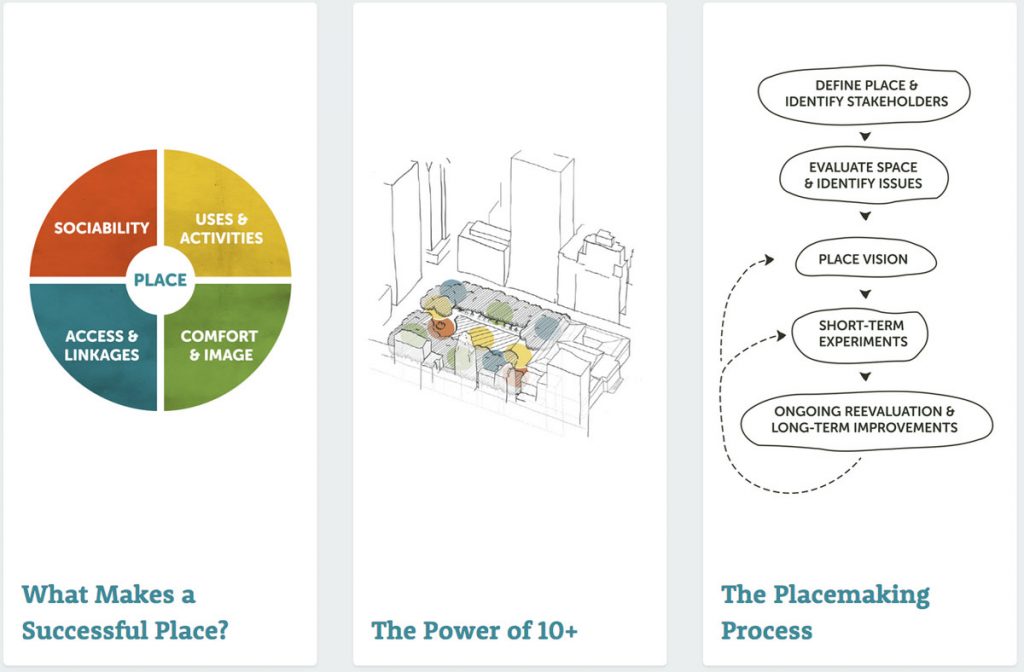
Placemaking diagrams from the Project for Public Spaces website
The idea of placemaking covers a range of possibilities as wide as place itself – it can involve an act of personal self-awareness about experiences and memories of somewhere, or planting a garden, or contributing to neighborhood awareness, or master-planning a new development. The notion that has had most impact on place identities is one is one that involves an element of design that will make somewhere more attractive. The American consulting firm Project for Public Spaces, which describes itself as the “central hub of the global placemaking community,” offers this definition: “Placemaking is both an overarching idea and a hands-on tool for improving a neighbourhood, city or region.” The hands-on tool requires community involvement to devise ways to make otherwise dispiriting parts of cities attractive, for instance by closing streets or widening sidewalks or adding artwork that will attract people and encourage business vitality.
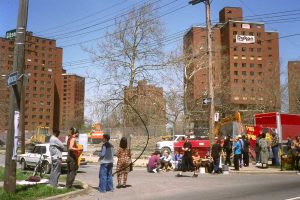
Place unmaking in Detroit in 2000. The modernist apartment towers have been wired for demolition, and some former residents have gathered in small protest to witness the destruction of their former homes
Placemaking is usually promoted or written about with unalloyed enthusiasm. But all placemaking is in some way an act of creative destruction, an act of replacement. Jame Kalven, who spent many years working and placemaking (by which he means community building) in the public housing projects in Chicago, uses the term “unmaking of place” to describe the consequences of the “Plan for Transformation.” Under that plan the city demolished modernist projects in order to make places supposedly better but which were, in his view, an assault on the identities of those for whom these doomed places were home. His argument is significant because those formerly placeless projects had been transformed into territories of meanings for their inhabitants.
Comment. There are really two conclusions from this summary of changes to way places have been made since 1970. The first is the obvious one that the ways places are now being made and modified is very different from how this happened in the 1960s. This is apparent simply by looking at whatever remains of shopping plazas or social housing projects from then, although many of them have been demolished or deeply renovated. The second conclusion is less obvious. It is that these moves toward greater place distinctiveness are by no means perfect. For all its merits heritage protection is biased in its selections of what to protect, and World Heritage Sites are surrounded by placeless parking lots filled with tour buses. Place branding is a branch of the faceless processes of neo-liberal globalization. Placemaking has paradoxically become a global buzzword, often using a familiar kit of urban design practices – bollards, interlocking pavers. What seems to have happened is that the once clear distinction between place and placelessness has faded because distinctiveness and standardization have become intermingled.